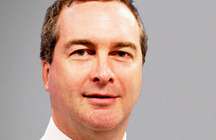Robert Hannigan
| Robert Hannigan CMG | |
|---|---|
 | |
| Director of the Government Communications Headquarters | |
|
Assumed office November 2014 | |
| Prime Minister |
David Cameron Theresa May |
| Minister |
Philip Hammond Boris Johnson |
| Preceded by | Iain Lobban |
| Personal details | |
| Born |
1965 (age 50–51) |
| Occupation | Intelligence officer |
Robert Peter Hannigan CMG (born 1965) is a senior British civil servant currently serving as the Director of the signals intelligence and cryptography agency the Government Communications Headquarters (GCHQ).
Early and family life
Hannigan was born in Gloucestershire and brought up in Yorkshire, and studied classics at Wadham College, Oxford[1] and continued his education at Heythrop College, University of London.[2] He is married with a son and a daughter.[3]
Career
After an early career in the private sector, Hannigan became Deputy Director of Communications for the Northern Ireland Office in 2000, Director of Communications for the Northern Ireland Office in 2001 and Associate Political Director for the Northern Ireland Office in 2004.[1][4] He served as the Director-General, Political as the Northern Ireland Office from 2005, taking over from Jonathan Phillips.[5][6]
In 2007, he replaced Sir Richard Mottram as the Head of Security, Intelligence and Resilience at the Cabinet Office, responsible for co-ordinating between the intelligence services and government,[4] and acting as Accounting Officer for the Single Intelligence Account which funds MI5, MI6 and GCHQ.[7] During his time in post, Hannigan led the review into a major data breach incident, and the subsequent report which is informally called the "Hannigan Report".[8]
Hannigan moved to the Foreign and Commonwealth Office as the Director-General of Defence and Intelligence with effect from 1 March 2010.[9] He was appointed Companion of the Order of St Michael and St George (CMG) in the 2013 New Year Honours for services to national security.[10][11]
Director of GCHQ
It was announced in April 2014 that Hannigan would succeed Iain Lobban as the Director of the signals intelligence and cryptography agency the Government Communications Headquarters (GCHQ) in the autumn of the year,[12] taking over in November 2014.[13] As of 2015, Hannigan was paid a salary of between £160,000 and £164,999 by GCHQ, making him one of the 328 most highly paid people in the British public sector at that time.[14]
On his first day in the role, Hannigan wrote an article in the Financial Times on the topic of Internet surveillance, stating that "however much [large US technology companies] may dislike it, they have become the command and control networks of choice for terrorists and criminals" and that GCHQ and its sister agencies "cannot tackle these challenges at scale without greater support from the private sector", arguing that most Internet users "would be comfortable with a better and more sustainable relationship between the [intelligence] agencies and the tech companies". Since the 2013 surveillance disclosures, large US technology companies have improved security and become less co-operative with foreign intelligence agencies, including those of the UK, generally requiring a US court order before disclosing data.[15][16] However the head of the UK technology industry group TechUK rejected these claims, stating that they understood the issues but that disclosure obligations "must be based upon a clear and transparent legal framework and effective oversight rather than, as suggested, a deal between the industry and government".[17]
Offices held
| Government offices | ||
|---|---|---|
| Preceded by Jonathan Phillips |
Director-General, Political, Northern Ireland Office 2005–2007 |
Succeeded by Hilary Jackson |
| Preceded by Sir Richard Mottram Permanent Secretary, Intelligence, Security and Resilience |
Head of Security, Intelligence and Resilience Cabinet Office 2007–2010 |
Succeeded by Oliver Robbins Deputy National Security Adviser, Intelligence, Security and Resilience |
| Preceded by Mariot Leslie |
Director-General, Defence and Intelligence, Foreign and Commonwealth Office 2010–2014 |
Succeeded by Sarah Macintosh |
| Preceded by Sir Iain Lobban |
Director of GCHQ 2014–present |
Succeeded by Incumbent |
References
- 1 2 Kelly Fiveash (15 April 2014). "Ex-Tony Blair adviser is new top boss at UK spy-hive GCHQ". The Register. Retrieved 5 November 2014.
- ↑ "Heythrop College". The Complete University Guide. Retrieved 20 July 2015.
- ↑ "Appointment of the new Director of GCHQ" (Press release). GOV.UK. 15 April 2014. Retrieved 5 November 2014.
- 1 2 A & C Black (Dec 2011). "HANNIGAN, Robert Peter". Who's Who 2012, online edn. Oxford University Press. Retrieved 21 December 2011.
- ↑ Northern Ireland Office (December 2005). "Autumn Performance Report 2005" (PDF). p. 5. Retrieved 23 December 2011.
- ↑ Northern Ireland Office (May 2005). "Departmental Report 2007" (PDF). p. 3. Retrieved 23 December 2011.
- ↑ "Funding". MI5. Retrieved 5 November 2014.
- ↑ Cabinet Office (June 2008). "Data Handling Procedures in Government: Final Report". Retrieved 21 December 2011.
- ↑ Foreign and Commonwealth Office (30 June 2010). "Resource Accounts 2009-10" (PDF). p. 10. Retrieved 21 December 2011.
- ↑ The London Gazette: (Supplement) no. 60367. p. 3. 29 December 2012.
- ↑ New Year Honours lists 2013 Cabinet Office
- ↑ Press Association (15 April 2014). "GCHQ names Foreign Office official Robert Hannigan as new chief". The Guardian. Retrieved 15 April 2014.
- ↑ "It is time to forge a post-Snowden settlement". Financial Times. 4 November 2014. Retrieved 4 November 2014.
- ↑ "Senior officials 'high earners' salaries as at 30 September 2015 - GOV.UK". www.gov.uk. 2015-12-17. Retrieved 2016-03-11.
- ↑ Robert Hannigan (3 November 2014). "The web is a terrorist's command-and-control network of choice". Financial Times. Retrieved 3 November 2014.
- ↑ Sam Jones and Murad Ahmed (3 November 2014). "Tech groups aid terror, says UK spy chief". Financial Times. Retrieved 3 November 2014.
- ↑ David Barrett (4 November 2014). "Tech giants reject GCHQ boss Robert Hannigan's call for deal with government". Daily Telegraph. Retrieved 5 November 2014.